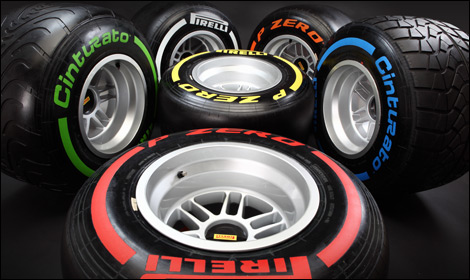Jan
23rd
Stay connected Subscribe to our RSS feed
Italian tire manufacturer and official tire supplier to Formula 1, Pirelli has revealed Wednesday in Milan its new range of tires for the 2013 F1 season.
The company says these new tires have been developed according to the wishes of the teams and the latest rules from world motorsport's governing body, the FIA. The most recent evolutions benefit the compounds, which have become softer, the structures, which are more flexible and the shoulders, which have been reinforced.
The defining characteristic of the 2013 Pirelli F1 tires is softer compounds all round, which will allow them to reach peak operating temperature faster and deliver lap times that are around 0.5 seconds faster than last year.
The objective of all these innovations, which work closely together, is to improve performance and increase thermal degradation, to ensure at least two pit stops per race and open up more strategic options for all the teams. Pirelli says that the bigger performance gap between the compounds will encourage overtaking throughout each race.
The sidewalls also look different, with colours that are more immediately striking and a brand new marking: orange, which comes in place of last year's silver to denote the hardest compound.
This year again, each F1 car will have 11 sets of tires available for the weekend, made up of six sets of the harder and five sets of the softer compound.
The company says these new tires have been developed according to the wishes of the teams and the latest rules from world motorsport's governing body, the FIA. The most recent evolutions benefit the compounds, which have become softer, the structures, which are more flexible and the shoulders, which have been reinforced.
 |
| Photo: Pirelli |
The defining characteristic of the 2013 Pirelli F1 tires is softer compounds all round, which will allow them to reach peak operating temperature faster and deliver lap times that are around 0.5 seconds faster than last year.
The objective of all these innovations, which work closely together, is to improve performance and increase thermal degradation, to ensure at least two pit stops per race and open up more strategic options for all the teams. Pirelli says that the bigger performance gap between the compounds will encourage overtaking throughout each race.
The sidewalls also look different, with colours that are more immediately striking and a brand new marking: orange, which comes in place of last year's silver to denote the hardest compound.
This year again, each F1 car will have 11 sets of tires available for the weekend, made up of six sets of the harder and five sets of the softer compound.
 The latest auto news, reviews, prices, product and vehicle releases.
The latest auto news, reviews, prices, product and vehicle releases.